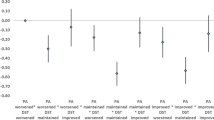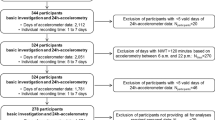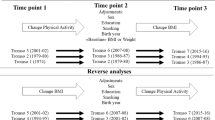Abstract
Objective:
To investigate patterns of, and associations between, physical activity at work and in leisure time, television viewing and computer use.
Subjects:
4531 men and 4594 women with complete plausible data, age 44–45 years, participating in the 1958 British birth cohort study.
Methods:
Physical activity, television viewing and computer use (hours/week) were estimated using a self-complete questionnaire and intensity (MET hours/week) derived for physical activity. Relationships were investigated using linear regression and χ2 tests.
Results:
From a target sample of 11 971, 9223 provided information on physical activity, of whom 75 and 47% provided complete and plausible activity data on work and leisure time activity respectively. Men and women spent a median of 40.2 and 34.2 h/week, respectively in work activity, and 8.3 and 5.8 h/week in leisure activity. Half of all participants watched television for ⩾2 h/day, and half used a computer for <1 h/day. Longer work hours were not associated with a shorter duration of leisure activity, but were associated with a shorter duration of computer use (men only). In men, higher work MET hours were associated with higher leisure-time MET hours, and shorter durations of television viewing and computer use. Watching more television was related to fewer hours or MET hours of leisure activity, as was longer computer use in men. Longer computer use was related to more hours (or MET hours) in leisure activities in women.
Conclusions:
Physical activity levels at work and in leisure time in mid-adulthood are low. Television viewing (and computer use in men) may compete with leisure activity for time, whereas longer duration of work hours is less influential. To change active and sedentary behaviours, better understanding of barriers and motivators is needed.
This is a preview of subscription content, access via your institution
Access options
Subscribe to this journal
Receive 12 print issues and online access
$259.00 per year
only $21.58 per issue
Buy this article
- Purchase on Springer Link
- Instant access to full article PDF
Prices may be subject to local taxes which are calculated during checkout
Similar content being viewed by others
References
Aadahl M, Kjaer M, Jørgensen T (2007). Influence of time spent on TV viewing and vigorous intensity physical activity on cardiovascular biomarkers. The Inter 99 study. Eur J Cardiovasc Prev Rehabil 14, 660–665.
Ainsworth BE, Haskell WL, Whitt MC, Irwin ML, Swartz AM, Strath SJ et al. (2000). Compendium of physical activities: an update of activity codes and MET intensities. Med Sci Sports Exerc 32, S498–S504.
Armstrong T, Bauman A, Davies J (2000). Physical activity patterns of Australian adults. Results of the 1999 National Physical Activity Survey. Canberra. Australian Institute of Health and Welfare. http://www.aihw.gov.au/publications/index.cfm/title/5944.
Atherton K, Fuller E, Shepherd P, Strachan D, Power C (2008). Loss and representativeness in a biomedical survey at age 45 years: 1958 British birth cohort. J Epidemiol Comm Health 62, 216–223.
Barengo NC, Hu G, Lakka TA, Pekkarinen H, Nissinen A, Tuomilehto J (2004). Low physical activity as a predictor for total and cardiovascular disease mortality in middle-aged men and women in Finland. Eur Heart J 25, 2204–2211.
Biddle SJH (2007). Sedentary Behavior. Am J Prev Med 33, 502–504.
Burton NW, Turrell G (2000). Occupation, hours worked, and leisure-time physical activity. Prev Med 31, 673–681.
Davey SG, Shipley MJ, Batty GD, Morris JN, Marmot M (2000). Physical activity and cause-specific mortality in the Whitehall study. Public Health 114, 308–315.
Department of Health (1995). More People More Active More Often Physical activity in England: A Consultation paper. The Stationary Office: London.
Department of Health (2004). Choosing Health: Making healthy choices easier. The Stationary Office: London.
Department for Transport (2000). Transport Ten Year Plan 2000. London http://www.dft.gov.uk/about/strategy/whitepapers/previous/transporttenyearplan2000.
Foster C, Hillsdon M, Cavill N, Allender S, Cowburn G (2005). Understanding Participation in Sport – a Systematic Review. Sport England: London.
Fuller E, Power C, Shepherd P, Strachan D (2006). Technical report on the National Child Development Study biomedical survey 2002–2004. Centre for Longitudinal Studies: London http://www.cls.ioe.ac.uk/library.
Hallal PC, Victora CG, Wells JC, Lima RC (2003). Physical inactivity: prevalence and associated variables in Brazilian adults. Med Sci Sports Exerc 35, 1894–1900.
Hamer M, Chida Y (2008). Active commuting and cardiovascular risk: a meta-analytic review. Prev Med 46, 9–13.
Kaplan GA, Strawbridge WJ, Cohen RD, Hungerford LR (1996). Natural history of leisure-time physical activity and its correlates: associations with mortality from all causes and cardiovascular disease over 28 years. Am J Epidemiol 144, 793–797.
King GA, Fitzhugh EC, Bassett Jr DR, McLaughlin JE, Strath SJ, Swartz AM et al. (2001). Relationship of leisure-time physical activity and occupational activity to the prevalence of obesity. Int J Obes 25, 606–612.
Kruger J, Yore MM, Ainsworth BE, Macera CA (2006). Is participation in occupational physical activity associated with lifestyle physical activity levels? J OccupEnvironMed 48, 1143–1148.
Kruger J, Yore MM, Kohl III HW (2007). Leisure-time physical activity patterns by weight control status: 1999-2002 NHANES. Med Sci Sports Exerc 39, 788–795.
Owen N, Bauman A (1992). The descriptive epidemiology of a sedentary lifestyle in adult Australians. Int J Epidemiol 21, 305–310.
Paffenbarger Jr RS, Hyde RT, Wing AL, Hsieh CC (1986). Physical activity, all-cause mortality, and longevity of college alumni. N Engl J Med 314, 605–613.
Pate RR, Pratt M, Blair SN, Haskell WL, Macera CA, Bouchard C et al. (1995). Physical activity and public health. A recommendation from the Centers for Disease Control and Prevention and the American College of Sports Medicine. JAMA 273, 402–407.
Popham F, Mitchell R (2006). Leisure time exercise and personal circumstances in the working age population: longitudinal analysis of the British household panel survey. J Epidemiol Community Health 60, 270–274.
Power C, Elliott J (2006). Cohort profile: 1958 British birth cohort (National Child Development Study). Int J Epidemiol 35, 34–41.
Rosengren A, Wilhelmsen L (1997). Physical activity protects against coronary death and deaths from all causes in middle-aged men. Evidence from a 20-year follow-up of the primary prevention study in Goteborg. Ann Epidemiol 7, 69–75.
Schnohr P, Scharling H, Jensen JS (2003). Changes in leisure-time physical activity and risk of death: an observational study of 7,000 men and women. Am J Epidemiol 158, 639–644.
Sports Council and Health Education Authority (1992). Allied Dunbar Health and Fitness Survey. A report on activity patterns and fitness levels: London.
Stender M, Hense HW, Doring A, Keil U (1993). Physical activity at work and cardiovascular disease risk: results from the MONICA Augsburg study. Int J Epidemiol 22, 644–650.
Wannamethee SG, Shaper AG, Walker M (1998). Changes in physical activity, mortality, and incidence of coronary heart disease in older men. Lancet 351, 1603–1608.
Wareham NJ, Jakes RW, Rennie KL, Mitchell J, Hennings S, Day NE (2002). Validity and repeatability of the EPIC-Norfolk Physical Activity Questionnaire. Int J Epidemiol 31, 168–174.
Wijndaele K, Duvigneaud N, Matton L, Duquet W, Delecluse C, Thomis M et al. (2007). Sedentary behaviour, physical activity and a continuous metabolic syndrome risk score in adults. Eur J Clin Nutr. [e-pub ahead of print].
World Health Organisation (2006). Physical activity and health in Europe: evidence for action. WHO: Denmark.
Acknowledgements
We are grateful to the Measurement and Epidemiology of Physical Activity group at the Medical Research Council Epidemiology Unit, Cambridge, United Kingdom for sharing information on administering and utilizing data from the physical activity questionnaire (EPAQ2). Data collection at age 45 years was funded by the UK Medical Research Council, Grant G0000934. Statistical analyses was supported by the Medical Research Council and also by the Secretary of State for Health, Department of Health, England (NHS R&D programme). The views and opinions expressed in the article represent those of the authors and do not necessarily reflect those of the Department of Health. Research at the UCL Institute of Child Health and Great Ormond Street Hospital for Children NHS Trust benefits from R&D funding received from the NHS Executive.
Author information
Authors and Affiliations
Corresponding author
Additional information
Guarantor: TJ Parsons
Contributors: TJP and CP developed the original idea. TJP and CT analyzed the data, and TJP wrote the first draft of the paper. All authors contributed to interpreting the data and writing the final version of the paper.
Rights and permissions
About this article
Cite this article
Parsons, T., Thomas, C. & Power, C. Estimated activity patterns in British 45 year olds: cross-sectional findings from the 1958 British birth cohort. Eur J Clin Nutr 63, 978–985 (2009). https://doi.org/10.1038/ejcn.2009.6
Received:
Revised:
Accepted:
Published:
Issue Date:
DOI: https://doi.org/10.1038/ejcn.2009.6
Keywords
This article is cited by
-
Time spent in sedentary posture is associated with waist circumference and cardiovascular risk
International Journal of Obesity (2017)
-
Levels of physical activity among a nationally representative sample of people in early old age: results of objective and self-reported assessments
International Journal of Behavioral Nutrition and Physical Activity (2014)
-
Early adulthood television viewing and cardiometabolic risk profiles in early middle age: results from a population, prospective cohort study
Diabetologia (2012)



